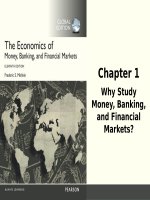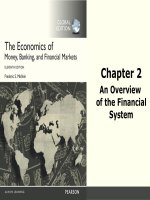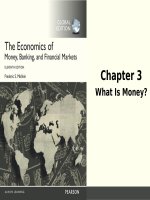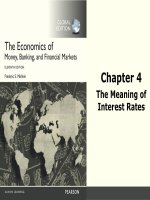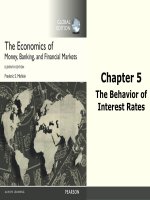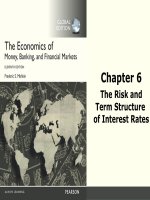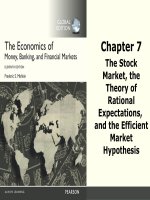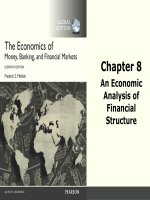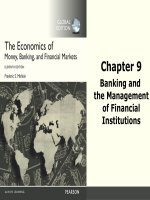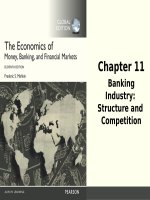The economics of money, banking, and financial institutions (11th edition) by f s mishkin ch24 monetary policy theory
Bạn đang xem bản rút gọn của tài liệu. Xem và tải ngay bản đầy đủ của tài liệu tại đây (2.03 MB, 41 trang )
Chapter 24
Monetary Policy
Theory
20-1
24-1
© 2016 Pearson Education Ltd. All rights reserved.
Preview
• This chapter uses the aggregate demandaggregate supply framework developed in
the preceding chapter to develop a theory of
monetary policy.
20-2
24-2
© 2016 Pearson Education Ltd. All rights reserved.
Learning Objectives
• Illustrate and explain the policy choices that
monetary policymakers face under the
conditions of aggregate demand shocks,
temporary supply shocks and permanent
supply shocks.
• Identify the lags in the policy process, and
summarize why they weaken the case for an
activist policy approach.
• Explain why monetary policymakers can target
any inflation rate in the long-run but cannot
target aggregate output in the long-run.
20-3
24-3
© 2016 Pearson Education Ltd. All rights reserved.
Learning Objectives
• Identify the sources of inflation and the role
of monetary policy in propagating inflation.
• Explain the unique challenges that monetary
policymakers face at the zero lower bound,
and illustrate how nonconventional
monetary policy can be effective under such
conditions.
20-4
24-4
© 2016 Pearson Education Ltd. All rights reserved.
Response of Monetary Policy to
Shocks
• Monetary policy should try to minimize the
difference between inflation and the inflation
target.
• In the case of both demand shocks and
permanent supply shocks, policy makers can
simultaneously pursue price stability and
stability in economic activity.
• Following a temporary supply shock, however,
policy makers can achieve either price stability
or economic activity stability, but not both. This
tradeoff poses a dilemma for central banks
with dual mandates.
20-5
24-5
© 2016 Pearson Education Ltd. All rights reserved.
Response to an Aggregate Demand
Shock
• Policy makers can respond to this shock in
two possible ways:
– No policy response
– Policy stabilizes economic activity and inflation in
the short run
• In the case of aggregate demand shocks,
there is no tradeoff between the pursuit of
price stability and economic activity stability.
20-6
24-6
© 2016 Pearson Education Ltd. All rights reserved.
Figure 1 Aggregate Demand Shock:
No Policy Response
20-7
24-7
© 2016 Pearson Education Ltd. All rights reserved.
Figure 2 Aggregate Demand Shock: Policy
Stabilizes Output and Inflation in the Short Run
20-8
24-8
© 2016 Pearson Education Ltd. All rights reserved.
Response to a Permanent Supply
Shock
• There are two possible policy responses to a
permanent supply shock:
- No policy response
- Policy stabilizes inflation
20-9
24-9
© 2016 Pearson Education Ltd. All rights reserved.
Figure 3 Permanent Supply Shock:
No Policy Response
20-10
24-10
© 2016 Pearson Education Ltd. All rights reserved.
Figure 4 Permanent Supply Shock:
Policy Stabilizes Inflation
20-11
24-11
© 2016 Pearson Education Ltd. All rights reserved.
Response to a Temporary Supply
Shock
• When a supply shock is temporary,
policymakers face a short-run tradeoff
between stabilizing inflation and economic
activity.
• Policymakers can respond to the temporary
supply shock in three possible ways:
– No policy response
– Policy stabilizes inflation in the short run
– Policy stabilizes economic activity in the short
run
20-12
24-12
© 2016 Pearson Education Ltd. All rights reserved.
Figure 5 Response to a Temporary Aggregate
Supply Shock: No Policy Response
20-13
24-13
© 2016 Pearson Education Ltd. All rights reserved.
Figure 6 Response to a Temporary Aggregate
Supply Shock: Short-Run Inflation Stabilization
20-14
24-14
© 2016 Pearson Education Ltd. All rights reserved.
Figure 7 Response to a Temporary Aggregate
Supply Shock: Short-Run Output Stabilization
20-15
24-15
© 2016 Pearson Education Ltd. All rights reserved.
The Bottom Line: The Relationship Between
Stabilizing Inflation and Stabilizing Economic
Activity
• We can draw the following conclusions from
this analysis:
1. If most shocks to the economy are aggregate
demand shocks or permanent aggregate supply
shocks, then policy that stabilizes inflation will also
stabilize economic activity, even in the short run.
2. If temporary supply shocks are more common, then
a central bank must choose between the two
stabilization objectives in the short run.
3. In the long run there is no conflict between
stabilizing inflation and economic activity in response
to shocks.
20-16
24-16
© 2016 Pearson Education Ltd. All rights reserved.
How Actively Should Policy Makers
Try to Stabilize Economic Activity?
• All economists have similar policy goals (to
promote high employment and price
stability), yet they often disagree on the
best approach to achieve those goals.
• Nonactivists believe government action is
unnecessary to eliminate unemployment.
• Activists see the need for the government
to pursue active policy to eliminate high
unemployment when it develops.
20-17
24-17
© 2016 Pearson Education Ltd. All rights reserved.
Lags and Policy Implementation
• Several types of lags prevent policymakers
from shifting the aggregate demand curve
instantaneously:
– Data lag: the time it takes for policy makers to
obtain data indicating what is happening in the
economy
– Recognition lag: the time it takes for policy
makers to be sure of what the data are signaling
about the future course of the economy
20-18
24-18
© 2016 Pearson Education Ltd. All rights reserved.
Lags and Policy Implementation
• Several types of lags prevent policymakers
from shifting the aggregate demand curve
instantaneously:
– Legislative lag: the time it takes to pass
legislation to implement a particular policy
– Implementation lag: the time it takes for policy
makers to change policy instruments once they
have decided on the new policy
– Effectiveness lag: the time it takes for the
policy actually to have an impact on the economy
20-19
24-19
© 2016 Pearson Education Ltd. All rights reserved.
FYI: The Activist/Nonactivist Debate Over
the Obama Fiscal Stimulus Package
• Many activists argued that the government needed
to do more by implementing a massive fiscal
stimulus package.
• On the other hand, nonactivists opposed the fiscal
stimulus package, arguing that fiscal stimulus would
take too long to work because of long
implementation lags.
• The Obama administration came down squarely on
the side of the activists and proposed the American
Recovery and Reinvestment Act of 2009, a $787
billion fiscal stimulus package that Congress passed
on February 13, 2009.
20-20
24-20
© 2016 Pearson Education Ltd. All rights reserved.
Inflation: Always and Everywhere a
Monetary Phenomenon
• This adage is supported by our aggregate
demand and supply analysis because it
shows that monetary policy makers can
target any inflation rate in the long run by
shifting the aggregate demand curve with
autonomous monetary policy.
20-21
24-21
© 2016 Pearson Education Ltd. All rights reserved.
Figure 8 A Rise in the Inflation
Target
20-22
24-22
© 2016 Pearson Education Ltd. All rights reserved.
Causes of Inflationary Monetary
Policy
• High employment targets and inflation:
– Cost-push inflation results either from a
temporary negative supply shock or a push by
workers for wage hikes beyond what productivity
gains can justify.
– Demand-pull inflation results from policy
makers pursuing policies that increase aggregate
demand.
20-23
24-23
© 2016 Pearson Education Ltd. All rights reserved.
Figure 9 Cost-Push Inflation
20-24
24-24
© 2016 Pearson Education Ltd. All rights reserved.
Figure 10 Demand-Pull Inflation
20-25
24-25
© 2016 Pearson Education Ltd. All rights reserved.
